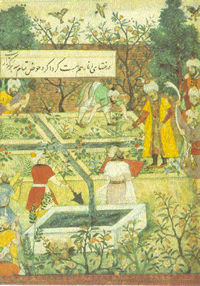The Mughal empire in India was founded by Zahir-ud-din Muhammad Babar, a Chaghatai Turkish ruler born on 14 February 1483. He was the son of the ruler of the petty kingdom of Farghana and inherited his father’s precarious throne when he was but eleven years old. Though it was Babar’s dream to rule Central Asia and capture Samarqand, he had fierce opposition from Persians and the Afghans. Consequently he turned his eyes from the West to the East, from the steppes of Central Asia to the fertile plains of Hindustan [India].
North India was at that time ruled by Afghan chieftains known as the Lodis. Babar invaded the Lodi-governed Punjab several times from his capital at Kabul before winning a decisive victory. In 1526, at the battle of Panipat, only a few miles from Delhi, Babar’s small but well-trained army of 12,000 men defeated a much larger force under the command of Ibrahim Lodi, the sultan of Delhi.
In the following year, Babar led his army to victory over a confederacy of Rajput kings headed by Rana Sanga, ruler of the state of Mewar of Rajasthan. Babar’s small army defeated the eighty thousand strong army of the Rajputs. These brisk victories gave Babar, who had extraordinary military acumen, a base from which to consolidate his rule in Northern India. His guns and his long-practiced use of the enveloping tactics of Central Asian cavalry proved to be effective against the Rajputs as well as the Afghans. His kingdom included Central Asian territories, Kabul, the Punjab, Delhi, and other parts of North India as far south as Gwalior and as far east as the Bihar.
Babar was more of a soldier than a politician. It has been suggested by historians that the government he set up was saifi (by the sword ) and not qalami (by the pen). Considerable parts of his empire were ruled by his ministers with full sovereignity. He was an orthodox Sunni muslim and loved architecture and music; he was also a master of Turki, his mother tongue, as well as Persian. The chronicles of his life, the Babarnama, remains widely used and is a masterpiece of that genre of literature. Babar appears not to have been enamored of Delhi and India, and in recent years his name has been mired in controversy. A mosque by the name of Babri masjid, apparently built in 1526 at his command, was destroyed on 6 December 1992 by Hindu militants. They claim that a Hindu temple, marking the site of Lord Rama’s birth, was destroyed at Babar’s orders, and a mosque built at that very site. For Hindu militants and chauvinists, Babar’s name has become synonymous with the history of Muslim tyranny and oppression, but almost nothing in the historical record warrants this reading.
Babar nominated his son Humayun as his successor and died on 30 December 1530 at the age of forty eight.



